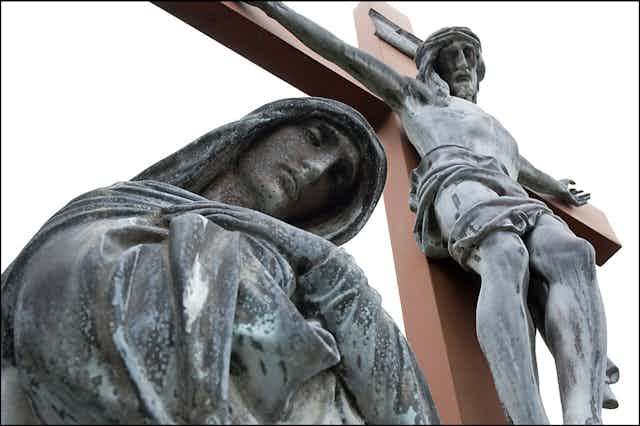Traditionalists and “Bible-believing Christians” can breathe a sigh of relief. Jesus, it turns out, probably didn’t have a wife after all. Or at least, the evidence to support the idea of a married Jesus is about as minimal as it ever has been.
Dan Brown style conspiracy theories about early Christian suppression of the “sacred feminine” can safely be placed back under the category of fiction.
For the briefest of moments, however, things might have looked different. In September 2012, Professor Karen King of Harvard University announced, to the “shock and awe” of academic colleagues, that a manuscript collector had passed on to her a Coptic text written on papyrus that contained the words:
Jesus said to them: “My wife, she is able to be my disciple”.
There were, of course, initial doubts about the authenticity of the text. But the full gamut of tests were run on the fragment and, as the Harvard Divinity School website still proclaims, the testing indicated the ink and papyrus were “ancient”.

It was clear even then that the text said nothing about Jesus’ actual marital status, and only reflected a later viewpoint. There was never a case for, and Professor King did not seek after, a complete reversal of the popular and scholarly consensus about Jesus’s likely celibacy. The most that might be claimed is that some early Christians believed Jesus to be married.
But then scholars really got to work on analysis of the text. The result was that the controversy moved away from the purported content of the papyrus fragment – later named the Gospel of Jesus’ Wife – and on to its provenance. The case for the defence of its authenticity, once bolstered by forensic science, now appears to be in tatters.
What was striking about the debate that ensued was that it took place initially in the medium of blogs and social media rather than the more usual channels of periodical publication.
Karen King’s own critical edition of the text was not published until 2014, but meanwhile scholars had been poring over PDFs of the transcribed text and original images.
Much of this work was eventually gathered up into a series of articles in a 2015 issue of New Testament Studies, one of the premier journals in the field of New Testament and Early Christian Studies. The results of critical study of the text were decisive: all the evidence pointed towards forgery.
The analysis itself was indicative of the kind of work that scholars, of many different religious persuasions and none, undertake in relation to religious texts from every era and tradition, including early Christianity.
First, New Testament scholar Francis Watson argued, with ample supporting evidence, that the text of the Gospel of Jesus’ Wife was largely a patchwork of words and phrases derived from the undoubtedly authentic Gospel of Thomas.
Just one example: the first line of the Gospel of Jesus’ Wife reads (in translation):
Not (to) me. My mother gave me li(fe).
These phrases are taken directly from the last line of the Coptic Gospel of Thomas 49 and the first line of saying 50.
This reliance on the Gospel of Thomas is ubiquitous in the Gospel of Jesus’ Wife. The forger had worked to ensure that some pronouns were changed from masculine to feminine forms, and had inserted two key terms: “Mary” and “my wife”. But the rest was derivative.
Second, it became clear that some unusual grammatical and physical features of the fragment seemed to resemble Michael Grondin’s PDF edition of the Gospel of Thomas, which was freely available online.
In the lines just mentioned, the definitive version of the Gospel of Thomas contains the regular Coptic marker for a direct object attached to the word for “life”.
The online interlinear (Coptic-English) edition used by the forger mistakenly leaves it out and so it doesn’t appear in Gospel of Jesus’ Wife. In other words, the fragment seems to be something of a cut and paste job.
In the most recent development Professor King recently made available a English translation of Gospel of Jesus’ Wife that was provided by the owner alongside the fragment itself.
Whoever did this translation has, it appears, made use of the same interlinear edition, and simply compiled the translation from it, including a word in English that doesn’t actually appear in the Coptic text of the Gospel of Jesus’ Wife fragment.
Of course, many questions remain. The “collector” who passed on the Gospel of Jesus’ Wife remains anonymous and so enquiries about provenance continue to be hindered. We have no clue as to who made the forgery or why.
But as biblical scholar Andrew Bernhard neatly points out, it is now pretty clear that the Gospel of Jesus’ Wife:
has no place in any discussion of ancient Christianity. It is part of modern Christian history now.
That same modern Christian history should also tell a wider story about the encounter between critical scholarship and religious texts. That encounter, and the body of scholarly work that it continues to produce, can and should make a vital (in both the literal and figurative senses) contribution to the study of the humanities within the academy and to the reflective practice of religious communities.
The same critical analysis that has demonstrated (within obvious contraints) that the Gospel of Jesus’ Wife is a forgery can and should be brought to bear on every religious text or tradition.
If that scholarship then shows us, as I think it does, that the Pentateuch wasn’t written by Moses, or that Jesus didn’t say most of the words attributed to him in John’s Gospel, or that the biblical texts are embedded in and thereby perpetuate patriarchal ideologies, then so much the better.
Religious faith cannot appeal to critical reason only when it finds the results to be conducive.
This article is part of The Conversation’s Religion + Mythology series.

